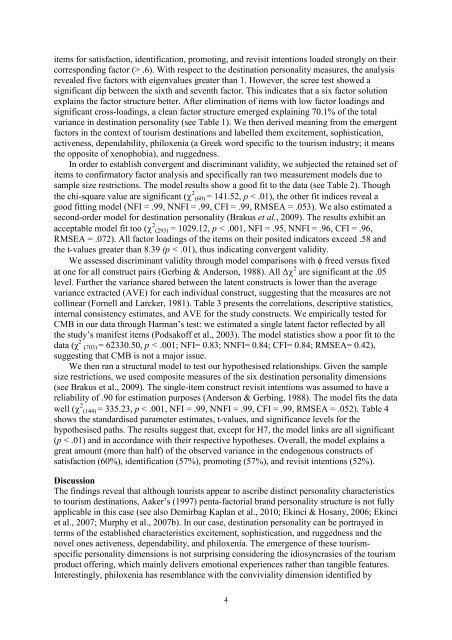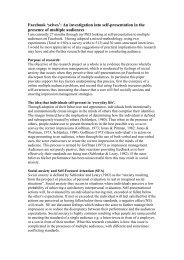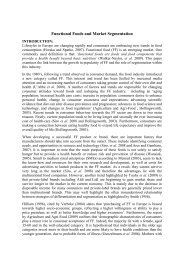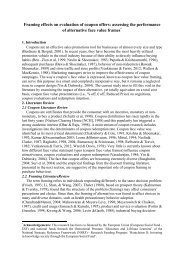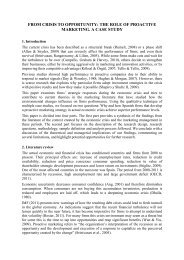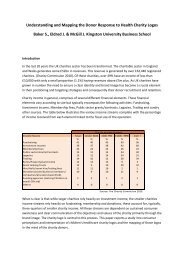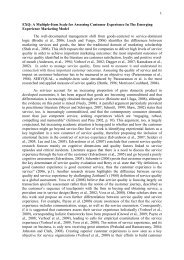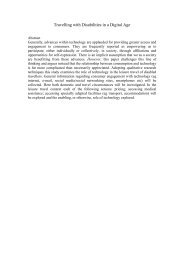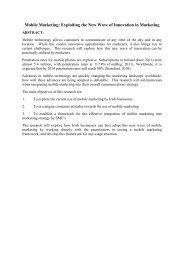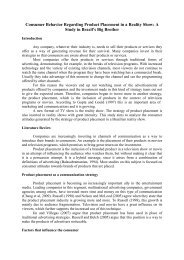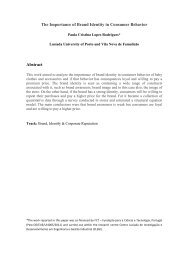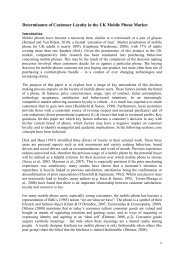Destination Personality: Effects on Satisfaction, Identification, Word-of
Destination Personality: Effects on Satisfaction, Identification, Word-of
Destination Personality: Effects on Satisfaction, Identification, Word-of
Create successful ePaper yourself
Turn your PDF publications into a flip-book with our unique Google optimized e-Paper software.
items for satisfacti<strong>on</strong>, identificati<strong>on</strong>, promoting, and revisit intenti<strong>on</strong>s loaded str<strong>on</strong>gly <strong>on</strong> their<br />
corresp<strong>on</strong>ding factor (> .6). With respect to the destinati<strong>on</strong> pers<strong>on</strong>ality measures, the analysis<br />
revealed five factors with eigenvalues greater than 1. However, the scree test showed a<br />
significant dip between the sixth and seventh factor. This indicates that a six factor soluti<strong>on</strong><br />
explains the factor structure better. After eliminati<strong>on</strong> <strong>of</strong> items with low factor loadings and<br />
significant cross-loadings, a clean factor structure emerged explaining 70.1% <strong>of</strong> the total<br />
variance in destinati<strong>on</strong> pers<strong>on</strong>ality (see Table 1). We then derived meaning from the emergent<br />
factors in the c<strong>on</strong>text <strong>of</strong> tourism destinati<strong>on</strong>s and labelled them excitement, sophisticati<strong>on</strong>,<br />
activeness, dependability, philoxenia (a Greek word specific to the tourism industry; it means<br />
the opposite <strong>of</strong> xenophobia), and ruggedness.<br />
In order to establish c<strong>on</strong>vergent and discriminant validity, we subjected the retained set <strong>of</strong><br />
items to c<strong>on</strong>firmatory factor analysis and specifically ran two measurement models due to<br />
sample size restricti<strong>on</strong>s. The model results show a good fit to the data (see Table 2). Though<br />
the chi-square value are significant (χ 2 (60) = 141.52, p < .01), the other fit indices reveal a<br />
good fitting model (NFI = .99, NNFI = .99, CFI = .99, RMSEA = .053). We also estimated a<br />
sec<strong>on</strong>d-order model for destinati<strong>on</strong> pers<strong>on</strong>ality (Brakus et al., 2009). The results exhibit an<br />
acceptable model fit too (χ 2 (293) = 1029.12, p < .001, NFI = .95, NNFI = .96, CFI = .96,<br />
RMSEA = .072). All factor loadings <strong>of</strong> the items <strong>on</strong> their posited indicators exceed .58 and<br />
the t-values greater than 8.39 (p < .01), thus indicating c<strong>on</strong>vergent validity.<br />
We assessed discriminant validity through model comparis<strong>on</strong>s with φ freed versus fixed<br />
at <strong>on</strong>e for all c<strong>on</strong>struct pairs (Gerbing & Anders<strong>on</strong>, 1988). All ∆χ 2 are significant at the .05<br />
level. Further the variance shared between the latent c<strong>on</strong>structs is lower than the average<br />
variance extracted (AVE) for each individual c<strong>on</strong>struct, suggesting that the measures are not<br />
collinear (Fornell and Larcker, 1981). Table 3 presents the correlati<strong>on</strong>s, descriptive statistics,<br />
internal c<strong>on</strong>sistency estimates, and AVE for the study c<strong>on</strong>structs. We empirically tested for<br />
CMB in our data through Harman’s test: we estimated a single latent factor reflected by all<br />
the study’s manifest items (Podsak<strong>of</strong>f et al., 2003). The model statistics show a poor fit to the<br />
data (χ 2 (703) = 62330.50, p < .001; NFI= 0.83; NNFI= 0.84; CFI= 0.84; RMSEA= 0.42),<br />
suggesting that CMB is not a major issue.<br />
We then ran a structural model to test our hypothesised relati<strong>on</strong>ships. Given the sample<br />
size restricti<strong>on</strong>s, we used composite measures <strong>of</strong> the six destinati<strong>on</strong> pers<strong>on</strong>ality dimensi<strong>on</strong>s<br />
(see Brakus et al., 2009). The single-item c<strong>on</strong>struct revisit intenti<strong>on</strong>s was assumed to have a<br />
reliability <strong>of</strong> .90 for estimati<strong>on</strong> purposes (Anders<strong>on</strong> & Gerbing, 1988). The model fits the data<br />
well (χ 2 (144) = 335.23, p < .001, NFI = .99, NNFI = .99, CFI = .99, RMSEA = .052). Table 4<br />
shows the standardised parameter estimates, t-values, and significance levels for the<br />
hypothesised paths. The results suggest that, except for H7, the model links are all significant<br />
(p < .01) and in accordance with their respective hypotheses. Overall, the model explains a<br />
great amount (more than half) <strong>of</strong> the observed variance in the endogenous c<strong>on</strong>structs <strong>of</strong><br />
satisfacti<strong>on</strong> (60%), identificati<strong>on</strong> (57%), promoting (57%), and revisit intenti<strong>on</strong>s (52%).<br />
Discussi<strong>on</strong><br />
The findings reveal that although tourists appear to ascribe distinct pers<strong>on</strong>ality characteristics<br />
to tourism destinati<strong>on</strong>s, Aaker’s (1997) penta-factorial brand pers<strong>on</strong>ality structure is not fully<br />
applicable in this case (see also Demirbag Kaplan et al., 2010; Ekinci & Hosany, 2006; Ekinci<br />
et al., 2007; Murphy et al., 2007b). In our case, destinati<strong>on</strong> pers<strong>on</strong>ality can be portrayed in<br />
terms <strong>of</strong> the established characteristics excitement, sophisticati<strong>on</strong>, and ruggedness and the<br />
novel <strong>on</strong>es activeness, dependability, and philoxenia. The emergence <strong>of</strong> these tourismspecific<br />
pers<strong>on</strong>ality dimensi<strong>on</strong>s is not surprising c<strong>on</strong>sidering the idiosyncrasies <strong>of</strong> the tourism<br />
product <strong>of</strong>fering, which mainly delivers emoti<strong>on</strong>al experiences rather than tangible features.<br />
Interestingly, philoxenia has resemblance with the c<strong>on</strong>viviality dimensi<strong>on</strong> identified by<br />
4


